Transfer by our own shuttle
Indeed, if you decide to enjoy our optional low cost shuttle service, we will come over to Athens airport upon your arrival time and will wait for you at the exit gate B (Schengen arrivals) of the airport.
We will welcome you, lead you immediately to the parking, load your luggage in our 10-seats airco minibus and carry you all straight to the South and our guesthouse in the heart of our dear olive grove. For a very cheap price of € 200 per family, consisting only in the price of our gasoline and Greek road tolls! With two stop-over on the road, along the Isthmus of Corinth and afterwards at the amphitheatre of Sparta.
For your own convenience and full discovery of the marvellous landscapes of Peloponnese, we will ask you to (try to) choose a flight landing at noon or in the early afternoon in Athens, so that you can benefit and fully enjoy your trip to us.
Let us have an example and imagine that your aircraft lands at Athens airport at 1:20 pm (daily Ryanair direct flight Brussels-Athens).
At 14:00 hrs we leave the airport area together and start our trip along the Attica Odos motorway created for the Olympic Games of 2004. The semicircular shape of this ambitious ring road surrounds the whole megalopole of Athens, its suburbs and its 5,000,000 inhabitants like a huge arc bent on the Aegean coastline.
45 minutes after having left Venizelos airport and been driving all along the Aegean Sea littoral, we suddenly reach the famous Canal of Corinth, one of the sweetest dreams of all human beings since earliest Antiquity. Because all the sailors knew that they had to skirt round all Peloponnese,- i.e. one week trip more before reaching the harbour of Pirea, close to the famous city of Athens,- as from the 6th century B.C. they started to imagine to dig a channel here between both Ionian and Aegean seas.
Across the old iron bridge over the isthmus of Corinth, we leave Central Greece (and its Attics province) and reach Peloponnese, the famous land of the Spartans, "best" enemies of antique Athens and our sunny and peaceful destination for your holidays. Leaving the main motorway from Athens to Patras (and its modern harbour open to Italy), we start to follow a wide and not busy motorway climbing to the high mountains of Tripoli. 800 meter altitude, 80 km distance, 45 minutes drive. At Tripoli, locally well-known as the best city for furniture craftsmen and also famous for its honey, its cottage cheese and its liqueur Tipota made of aromatic herbs, we leave the motorway and take either the national road to Sparta (56km) or the 2016 new motorway (80km), climbing till 915 meter altitude (snow in the winter, deciduous trees) before than descending back to the valley of Sparta that opens to the Ionian Sea (25km down the city). The very charming and clean modern discrete city of Sparta is still surrounded with high mountains (the very snowy Taygetos, 2417 meter high, and the lower Parnon, both of these mountains protecting the city as from earlier times) but the famous city of the Lacedemonians lost all its importance during the Middle Age when the city was invaded and occupied by the Ottomans. Nowadays, the famous 2nd city of the Antiquity, fatherland of Leonidas, is not a major town of Greece anymore. Some of its inhabitants will however tell you that their ancestral war is not yet finished and that Athens, capital of the modern Greek Republic, has become again the official winner of their old rivality.
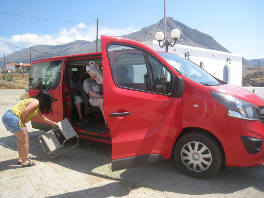
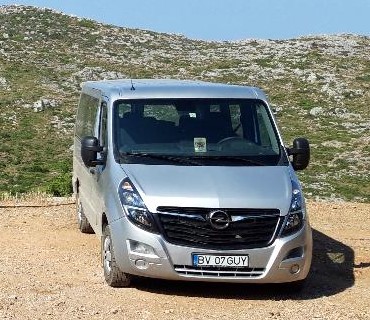
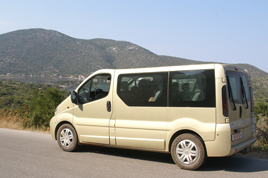
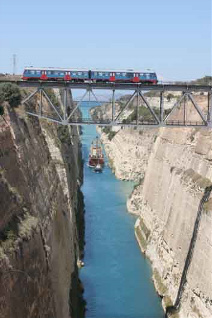
The famous isthmus of Korinthos.
While they are at it, they perhaps will also convince you that the actual economic slump will finally be in favour of peasants and agricultural provinces of the nation (read: their own area)! South Peloponnese indeed has always been poor and used to survive with goat cheese and meat, fish, octopus, oranges, olives, onions and tomatoes. There is no factory here (and by the way no pollution): the only potential industry for the future is probably the Tourism. If Big Brother Athens, the antique rival of Sparta, finally decides to allocate some major funds to the South to build an airport, to repair roads, to develop more motorways, harbours for ferries, create railways, hotels and touristic attractions…
Red flowers in May, yellow burned landscapes in June, green damped grass in December
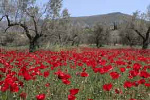

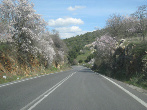

No money for factories, no money for archaeological excavations. This is the reason why you can walk (and we will do it together) free through all the ancient Sparta, without entrance fee, without watch nor any other explanations than the purely academic memories of your devoted guide. Let us take an unforgettable picture of its surprising but eloquent amphitheatre, whose tiers are still half buried and covered by grass and flowers (when not jumped over by trial bikes!).
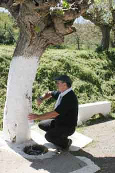
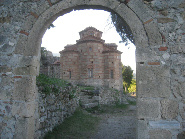
Nerodendro, UNESCO byzantine site of Mystras. the tap-tree!
By the way, did you know that Sparta has got another major reason for you to come back here by yourself during your stay and to pay a visit to its surroundings? You absolutely need to go to the citadel of Mystras (3 miles away from the centre of Sparta) where some knights from the Holy Crusades took refuge at the bottom of the protective high mountain of Sparta (Taygetus, 7897 feet), on a narrow peak covered with walls and still divided into two cities with an upper and a lower gate. Actively restored by UNESCO, the impressive site of Mystras has been meritoriously awarded as World Heritage Site. Three hours are necessary for its visit, walking from the Upper gate and from church to church, to the exit of the site at its Lower gate: unfortunately no time thus for us to do it on the way from the airport to our guesthouse. But we really recommend you to do it during your stay with us, as we are only at a distance of 60 miles (100km) from it.These last 60 miles from Sparta (via Skala, Asopos, Papadianika, Elika) to our dear village of Agioi Apostoloi (the Holy Apostles) will allow you to discover the deep Far-South of Greece, along picturesque and colourful (good surfaced) minor roads: snaking down the last finger of Europe, disrupting empty villages asleep in the sun, avoiding (true) sleeping dogs in the shadow of orange trees, running along wild sandy beaches, bordering yellow or dark-red cliffs, rounding capes pointing their Genoese towers, winding around little ports of fishers like Archangelos or Plytra, unceasingly crossing more and more olive trees replacing gradually the many dark-green orange groves of Skala area.
But why are there so many orange trees between both second and third fingers of Peloponnese and no one firther South on the road? Just because orange trees do hate windy areas and need quiet places to grow perfectly. On the contrary, olive trees love windswept and steeply slopes. Look at their leaves: they are dark green on the top and silvered on the back side. Dark colour absorbs heat, light silver colour repels it. The movement of the leaves created by the breeze mixes those temperatures and gives oxygen to the olive tree. So that we can say that the more wind blows, the best will be the olive oil!
If you cannot stand the heat, you will never suffer in our olive groves because there is always air here and it is never stuffy, even during dog days and heat waves (in Athens!).
As you can see, we have had a long chat on the road, from the airport till the guesthouse.
And here we are! Our Little Lost Paradise is yours. Here are your keys. Let me help you for the luggage. The children are tired, aren’t they? This way, kids. Here is your room. And now, your turn, parents. The fridge is still operating. Let me show you how the air-conditioning works. Caution for the shower, solar cells give very hot water in Greece! What about a short rest before than driving you to the restaurant of the village or… to our guest-table at home at one of our private terraces with view to the quiet lagoon, the flickering lights of Neàpoli and the sharp cut of our both islands under the moon?

Text and photos: Guy de LEUZE, European Journalist of Tourism.
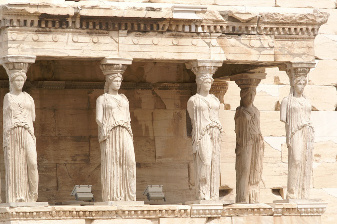
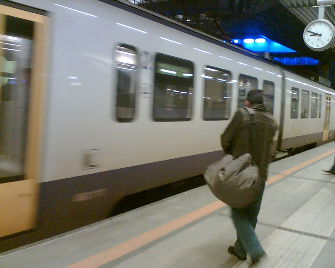
When booking your stay in our guesthouse (apply on our webpage entitled “Booking”), do not forget to ask us for our shuttle service from the airport + specify your day of arrival and local expected time of landing + airline company. Our optional service of shuttle is not compulsory but is probably the cheapest, the easiest and the best way for you to come to us and to discover our region through our explanations during the journey. No stress on the road. No risk to get lost. No gas nor tolls to give out. But the certainty to see the best highlights along the itinerary. To be informed about the antique and modern history of Greece, its geography, its politics, its crisis, its points of view about Europe, Brussels, the migrants... but of course above all about the traditions and basic language of modern Greece and greek modern language, local curiosities and celebrations during your stay, beaches to be seen, places to be, tips for islands and so on.
TIP!
Some of our international guests wish to pay a visit to Athens before (or after) their holidays with us in the South. To climb up the Acropolis and discover its Parthenon and Erechtheion temples (+ visit of the recently renewed Archaeological Museum) are no doubt imperative for any visitor of Greece and his (tall) children. However, apart from the world-famous hill of the Acropolis, its very close Plaka quarter (restaurants) and the changing of the evzone’s guard in front of the Parliament (if there is no general strike or political event in Syntagma, main place of all the riots), Athens is a crowded, very hot and (in the summertime) highly polluted megalopole without major interest, for its antique shape and monuments were completely destroyed by fires and robberies during both Venitian and Turkish occupations. When Greece became independent in 1830, Athens was only a village of 8,000 inhabitants and nothing but the Acropolis (and some minor ruines) subsisted from its wealthy and glorious antique past.
That is the reason why we propose to our guests to land at Athens Venizelos airport, to take a cab (or bus nr 95) to Athens-centre, to book an hotel in advance (we might recommend you some of them), to leave their luggage in it, to have a dinner at the Plaka, to spend the night at the hotel, to pay a visit to the Acropolis the next morning and… to wait for us at their hotel. We will welcome them at noon -or in the early afternoon- with our minibus (same tariff as for the airport).
HOW TO REACH US WITHOUT OUR SHUTTLE
¤ By car + ferry from Italy. Ferries from Italian harbours of Trieste, Venice, Ancona, Bari, Brindisi.
The best choices seem to be:
- Trieste if you come from Austria and North or Central Europe (2 nights at sea, approx.35 hours)
- Venice, if you are not in a hurry and do come from Western Europe via Switzerland (approx.32 hours)
- Ancona (faster ferries, approx. 21 hours), if you do not have time and money to spend on the road and want to start your holidays in Greece as soon as possible
- Bari and Brindisi (approx. 15 hours on the boat) are cheaper but 1,000km farther (stress, risks, traffic, tiredness, gasoline and… Italian motorways tolls)
¤ By plane + rent a car at the airport. Tip: always try to book an air ticket combined with car rental (fly & drive formule), often cheaper than booking a car separately upon your arrival. In the summertime and peak periods, rental cars may be 3 times more expensive than in low season. Read carefully the contract before signing: real unlimited mileage? Full insurances? 2nd driver allowed? Additional car-wash? Do not forget that prices for gasoline (€1.7/litre) and tolls are very expensive in Greece and not included in your rental contract. Traffic in Athens is pretty disconcerting (bikers without helmets, zigzags, cars without number plates, speed limits general inobservance, left-lanes snail’s pacers, traffic on emergency lanes…).
Taking your GPS with you is a good idea, if equipped with actual Greece maps. Please be aware that roads signs in the South are only written in Greek and often inexistent.
¤ By plane + local buses. Cheaper than our shuttle! Yeah. Be aware that national bus services can drive you to the South. Just take bus nr 93 (or a taxi) from the airport to Kifissou road-station (approx.€5/person), then local KTEL bus to Neàpoli Laconia (approx. €40/person). The bus stops in most of the villages (trip about 7 hours!) and many drivers do not speak English fluently.
¤ By plane + partly railway (mixed solution “train + shuttle”: upon your arrival, straight inside the airport, you can take the railway to Korinthos (approx. price €12/person, but €18 for return ticket -valid one month-) and ask us on beforehand for coming and picking you at the railway station of Corinth. We will drive you from there to our guesthouse (€110 per family).
¤ Domestic flights. They are expensive, rarely synchronous with international ones and will land on Kythira Island where you will have to take a taxi to the harbour of Diakofti. You will stay there for hours, waiting for one of the twice a day (in the summertime only) ferries to Neàpoli (8km from our guesthouse). Price of the ferry: €22 return ticket, 1h10 sail. Consequently: random timing and rather difficult solution in practice.
¤ Other Greek airports. Some (not daily) low-cost flights go to Kefalonia, Zakynthos, Arakas and Kalamata airports. Kefalonia and Zakynthos are far away from us and you will spend a lot of time on slow roads. Arakas is close to Patras but the flights are rare and never cheaper than to Athens. Last but not least, Kalamata is a very small airport, 58km from Sparta (or 80 by the new motorway), slightly closer to us than the one of Athens and seems to be interesting for you when coming from Germany (some weekly low-cost direct flights, check with your local airport).
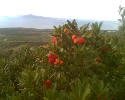

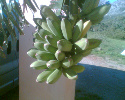

 Endless flowers, fruit and perfumes of our oliveyard. These are the daily surroundings of our guesthouse all along the year...
Endless flowers, fruit and perfumes of our oliveyard. These are the daily surroundings of our guesthouse all along the year...




